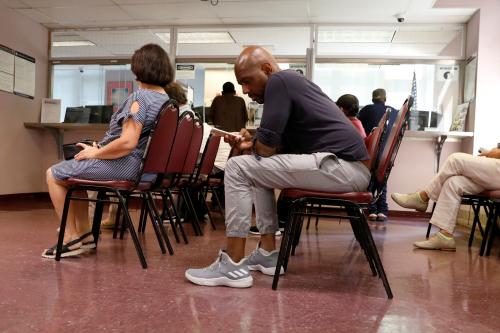This op-ed was originally posted in Real Clear Markets.
At first blush, the 2019 Social Security Trustees Report contains little news. Most of the projections are little changed from a year ago. The retirement and survivors trust fund is projected to run dry in 2034, the same as last year. But someone focusing only on these headline numbers would miss some remarkable news—that a crisis in the Disability Insurance (DI) program has largely disappeared. In 2015 the DI trust fund was expected to run out of money in just over one year. If that happened 11 million DI beneficiaries would have faced an abrupt benefit cut of nearly 20 percent. The 2019 projection indicates that the DI program can pay all scheduled benefits for the next 33 years—without any tax increase.
What accounts for this turnaround? First, to stave off impending benefit cuts Congress boosted DI revenues for three years, enough to allow scheduled benefits to be paid until 2022. It gave Congress time to decide what to do over the longer run…raise revenues, curtail access to the program, or find ways to help beneficiaries return to gainful economic activity. But, compared to the long-run funding gap, this temporary revenue increase was microscopic. The financial problems were not new; DI outlays had been running ahead of revenues since 2009, and members of Congress had been unable to agree on what to do about it. The 2015 action, though vital, looked like the cliché, ‘kicking the can down the road.’
What happened next has stunned actuaries, economists, and analysts of all stripes. The number of people applying for disability benefits dropped…and kept on dropping. Some decline was expected as the economy recovered from the Great Recession and demand for workers increased. But the actual fall in applications has dwarfed expectations. In addition, the share of applicants approved for benefits has also fallen.
At first, the Social Security Actuaries couldn’t quite believe that the fall-off in applications was anything other than a temporary deviation from longer-term trends. So, in 2018, the Trustees tweaked only their short-term projections, those covering the next decade, but they did not alter their assumptions for the rest of the 75-year projection period. Even this hesitant step led them last year to project that DI revenues would cover all scheduled benefits until 2032.
This year, as applications have continued to fall, the Trustees have revised their long-term assumptions. They now project that revenues, which five years ago were expected to cover 85 percent of outlays over the next seventy-five years, are now expected to cover 95 percent of outlays. And if the drop in applications persists, current revenues may be adequate to cover currently scheduled benefits indefinitely.
This reversal is good news for those who believe that the Disability Insurance program is fundamentally sound and feared that financial shortfalls would cause Congress out of financial fear to erect new barriers to access or to cut benefits. Those who see the program as flawed and ripe for restructuring may fear that the good financial news will weaken reform efforts. Most close observers of the Disability Insurance program agree that its design and administration can and should be improved.
Whatever one’s views about the desirability of restructuring DI, the conspicuous failure of a key projection should remind policymakers of two key realities. First, projections are fragile things. Whether one is looking at future budget deficits or future Social Security balances, one is looking at the comparatively small difference between two much larger quantities—projected revenues and projected expenditures. Small errors in either side of the ledger can cause huge proportionate changes in the difference between them. The future course of both revenues and expenditures depends on assumed growth rates, small errors in which compound to large quantities over time.
In the case of Disability Insurance, the drop in the assumed rate at which people apply for disability benefits—from 5.4 to 5.2 per thousand in the assumed annual, age-sex adjusted application rate—was sufficient to keep projections of the Disability Insurance trust fund balance in the black for an additional twenty years. If application rates remain low, the actuaries may well, at some point, conclude that even 5.2 is too high. Of course, trends could reverse. The financial crisis confronting DI just a few years back could return. Uncertainty goes both ways.
Given these uncertainties and the profound impact that changes in the Disability Insurance program can have on the vulnerable population that it serves, legislators should draw a second lesson from this year’s Trustees Report. Projections are not reality. While projections are an essential input into policy formation, they are guesses…informed guesses, to be sure…about the future. Legislators should consider with particular care changes in laws that immediately and profoundly affect vulnerable people based on guesses, even well-informed guesses, about future trends. It now looks like the Disability Insurance program’s revenues will exceed outlays over the next two decades. Beyond question, it makes sense to continue to try to improve program administration and, where possible, to help those now receiving benefits to return to gainful activity. But it would be callous to restrict access to Disability Insurance benefits today purely based on fragile projections of future events.
The Brookings Institution is committed to quality, independence, and impact.
We are supported by a diverse array of funders. In line with our values and policies, each Brookings publication represents the sole views of its author(s).





Commentary
Op-edThe remarkable news behind the 2019 Social Security Trustees Report
April 22, 2019